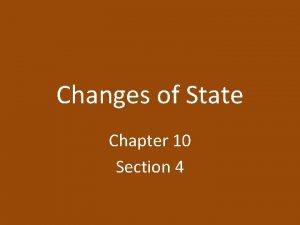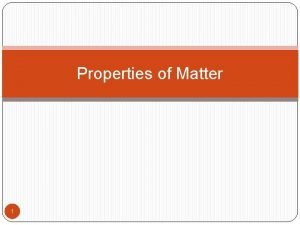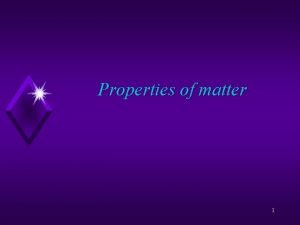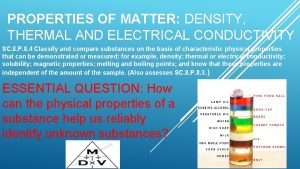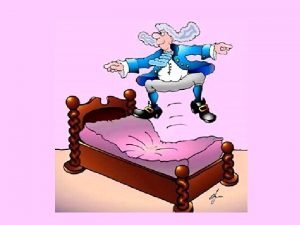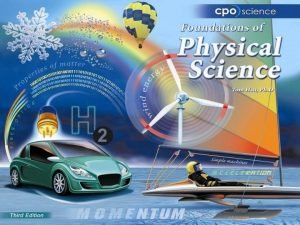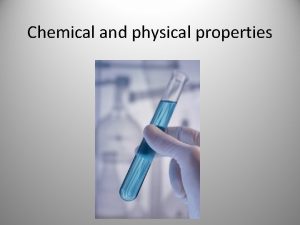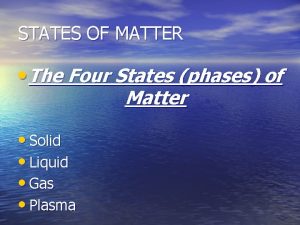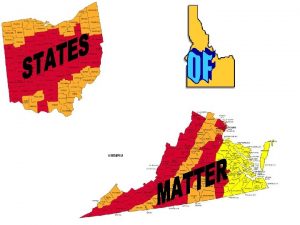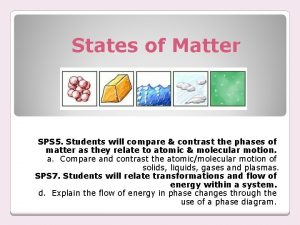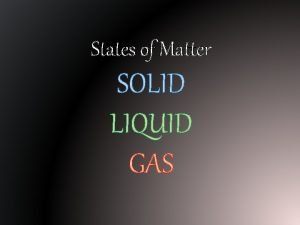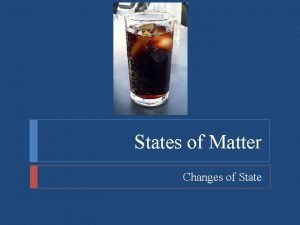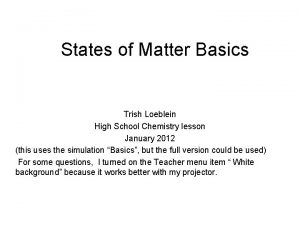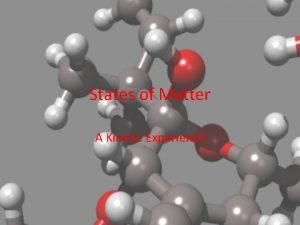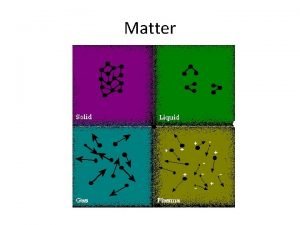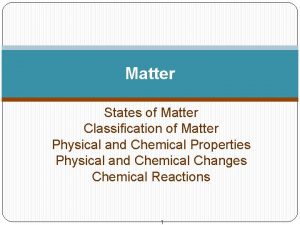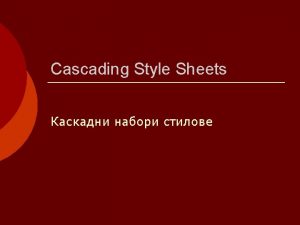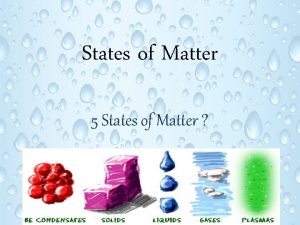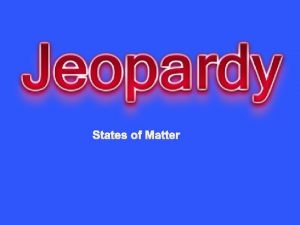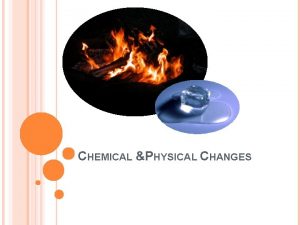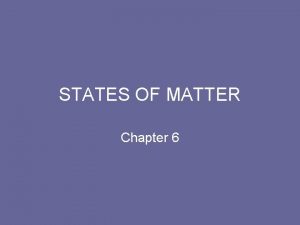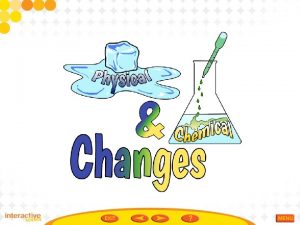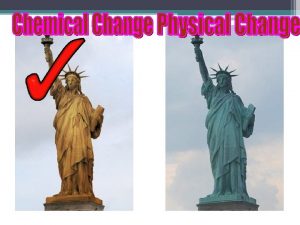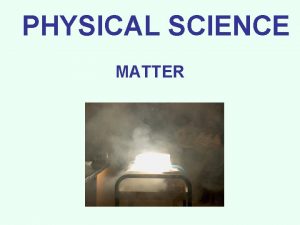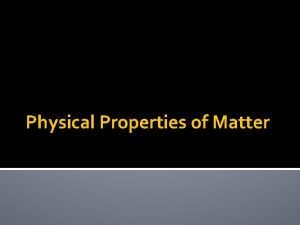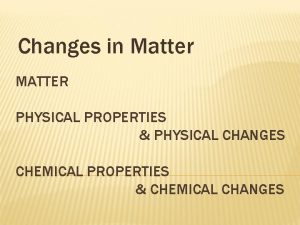Chapter 11 States of Matter Physical states Property































- Slides: 31

Chapter 11 States of Matter

Physical states

Property differences among Physical states • Compressibility: measure of volume change resulting from pressure change. • Thermal Expansion: Measure of volume change resulting from temperature change

The KMT of Matter: • Five statements used to explain three states. • Matter is composed of discrete tiny particles. • Particles are in constant motion and possess K. E (energy because of motion). • Particles interact through attractions and repulsions and possess P. E(stored energy).

The KMT of Matter: • Particles of opposite charges attract, like charges repel. • Electrostatic force: An attractive force or repulsive force that occurs between charged particles. • The K. E (velocity) increases as temp increases. • Particles in a system transfer energy through elastic (total KE remains constant) collisions.

The Solid State: • Physical state characterized by a dominance of P. E (cohesive forces) over K. E (disruptive forces). • Strong cohesive forces hold particles in fixed positions, def S and def V. • Large number of particles in a unit volume, high density.

The Solid State: • Very little space in-between particles, small compressibility. • Increase in temp causes K. E to increase , very small thermal expansion.

The Liquid state: • Physical state characterized by P. E and K. E of same magnitude. • Definite volume and indefinite shape. • High density: Particles not widely spread. • Small compressibility: Very less empty space. • Small thermal expansion

The Gaseous state: • Physical state characterized by a complete dominance of K. E over P. E • Indefinite V and Shape. • Low density: Particles are widely separated and few of them present in a given volume. • Large compressibility: Particles widely separated. • Moderate thermal expansion: Volume increases with increase in temp.

Compression involves decreasing amount of empty space in container.

A Comparison of Solids, Liquids and Gases • In gases particles are far away from each other compared to solids and liquids. • The distance ratio between particles of s, l, g: 1 to 10


Endothermic/Exothermic • Endothermic: System absorbs energy. Ex: melting, sublimation, evaporation. • Exothermic: System releases (exits) energy. Ex: deposition, condensation, freezing.


Heat energy and Specific Heat: • The SI unit for heat energy is the joule (pronounced “jool”). • Another unit is the calorie. • 1 Joule of energy is required to raise the temperature of 1 g of water by 1 C. • 1 Calorie= 4. 184 J. • 1 kcal= 4. 184 k. J.

Problems: • 1)Convert 55. 2 k. J into joules, kilocalories and calories. • 2)Convert 11, 900 calories into joules, kilocalories and kilojoules.

Specific Heat: • The specific heat of a substance is the quantity of heat required to change the temperature of 1 g of that substance by 1 o. C. • The units of specific heat in joules are: J/g C • Q= mc∆t • Q= heat in J, m= mass in g, c= specific heat in J/g C, ∆t= change in temperature in C

Problems • 3)Calculate the specific heat of a solid in J/go. C and in cal/ go. C if 1638 J raise the temperature of 125 g of the solid from 25. 0 o. C to 52. 6 o. C. • 4)Calculate the number of Joules of heat energy needed to increase the temperature of 50. 0 g of Cu from 21. 0 C to 80. 0 C. c of Cu= 0. 382 J/g C.

Evaporation of Liquids • Evaporation: Process by which molecules escape from a liquid to a gaseous phase. • Vapor: Gaseous sate of a substance at a temperature and pressure at which substance is normally a liquid or solid. • Equilibrium state: Two opposite processes take place at same rate.


Vapor Pressure of liquids • Vapor pressure: Pressure exerted by a vapor above a liquid when liquid and vapor are at equilibrium. • Volatile: Readily evaporates at RT. • Boiling: Conversion from liquid to vapor (evaporation) occurs within the body through bubble formation.

Vapor Pressure of liquids • Boiling point: Temperature of a liquid at which the vapor pressure of the liquid becomes equal to the external atmospheric pressure exerted on the liquid. • Normal boiling point: Temperature of liquid at which it boils under a pressure of 760 mm Hg.

Intermolecular forces in Liquids • Intermolecular force: Attractive forces between molecules. • Weak forces compared to intra molecular.

Within molecules, chem bonds Between molecules

Dipole-Dipole interactions • Dipole-Dipole interactions: occurs between polar molecules.

Hydrogen bond H is covalently bonded to a highly electronegative element of small size(F, O , N). It is a very strong dipole-dipole interaction. Ex: water.



London Forces Weakest type of all intermolecular. Occurs between an atom and a molecule.

Ion dipole interactions • Occurs between an ion and a polar molecule

Ion-Ion interactions Ionic compounds dissolved in water.
 Chemical property definition
Chemical property definition Chapter 2 section 1 classifying matter answer key
Chapter 2 section 1 classifying matter answer key Chapter 12 states of matter study guide
Chapter 12 states of matter study guide Chapter 10 review states of matter section 4
Chapter 10 review states of matter section 4 Chapter 11 - states of matter: liquids and solids
Chapter 11 - states of matter: liquids and solids Associative property vs commutative property
Associative property vs commutative property Obstructed and unobstructed heritage
Obstructed and unobstructed heritage Common properties of matter
Common properties of matter General property of matter
General property of matter Electrical properties of matter
Electrical properties of matter What property of matter that describes a rusty anchor.
What property of matter that describes a rusty anchor. Elasticity property of matter
Elasticity property of matter 12 properties of matter
12 properties of matter Helium physical and chemical properties
Helium physical and chemical properties Chapter 5 lesson 1 physical geography of the united states
Chapter 5 lesson 1 physical geography of the united states Classification of matter section 1 composition of matter
Classification of matter section 1 composition of matter White matter
White matter Section 1 composition of matter
Section 1 composition of matter Brain falx
Brain falx Classification of matter section 1 composition of matter
Classification of matter section 1 composition of matter Gray matter and white matter
Gray matter and white matter Grey matter and white matter in brain
Grey matter and white matter in brain Energy naturally flows from warmer matter to cooler matter
Energy naturally flows from warmer matter to cooler matter States of matter foldable
States of matter foldable Four phases of matter
Four phases of matter Four states of matter
Four states of matter States of matter
States of matter Thermal energy in states of matter
Thermal energy in states of matter Changing state
Changing state Phet states of matter basics
Phet states of matter basics 5 states of matter
5 states of matter Solid liquid venn diagram
Solid liquid venn diagram



